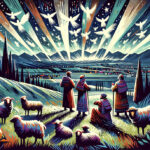
Jesus, walking from Bethany, is trekking onward toward his crucifixion in Jerusalem. And Mark lets us know that the Savior is hungry. So he does what so many have done upon a walk in the Middle East, he looks for something edible on the trees. Off in the distance he sees a fig tree that is “in leaf” (Mk. 11.13), so he goes “to see if he could find anything on it.”
It should be noted that the fig trees in this region begin to have early or smaller figs that grow from the previous year’s sprouts. These early figs would typically appear at about the same time or even before the new year’s leaves. These smaller figs were known to supply the poor and hungry with quick sustenance as they traveled about. It is important to note that the annual figs or the large figs did not come until later in the year, typically after August.
This becomes important in this passage. Jesus is of course descending upon Jerusalem here on the week of Passover. It is probably late March or early April. As a result, the large figs have not yet arrived. So here we have Jesus, who is hungry ,walking up to this fully leaved fig tree in the season where there should be small figs for pilgrims who are hungry. However, we read that this is not the case:
And seeing in the distance a fig tree in leaf, he went to see if he could find anything on it. When he came to it, he found nothing but leaves, for it was not the season for figs (Mk. 11.13)
Jesus comes to a tree that has the appearance of fruit (it has leaves) and so therefore should satisfy his hunger. However, upon a close inspection of the tree he finds it barren and fruitless.
The next words from Jesus might be a surprise to some:
And he said to it, “May no one ever eat fruit from you again.” And his disciples heard it. (v.14)
Jesus curses the fig tree for its lack of fruit.
Now did the tree do anything wrong? Of course not. So what is the significance of this “cursing”?
If we keep reading we see that Jesus soon after goes into the temple. He comes upon a bustling religious event. There are lots of people, animals, noises, and activities. Imagine the sights, sounds, and smells that would have greeted the Savior’s senses. Jesus is infuriated with a holy anger, and he carries out a Messianic sting operation on the temple. We read, “And he would not allow anyone to carry anything through the temple.” (11.16)
The temple was the place where people would go to meet God. They would have their greatest need fulfilled through satisfied fellowship with Jehovah. From a distance the temple appeared to be doing a pretty well, it appeared to have it together. The tree had leaves, if you will. However, upon a closer inspection from the Savior the temple was, like the fig tree, barren and fruitless. The tree was a picture of Israel. It should have had fruit on it; after all it was the season, and it had leaves. Israel should have had fruit, but they rejected their Messiah.
What a dreadful irony here. The true temple comes to the temple, and there is such a polarizing reaction. On the one hand Jesus is infuriated. He runs through the temple and disrupts their worship with his presence and anger. And on the other hand we have the religious leaders infuriated. They hated and feared him (11.18). So goes the age-old war between the seed of the woman and the serpent (Gen. 3.15ff). This battle would be dealt with in blood-stained finality in a matter of days as the seed of the woman crushes the serpent’s head like a discarded cigarette. But in the meantime we see this battle raging through the religious leaders, the temple worshipers, and the Savior himself.


















